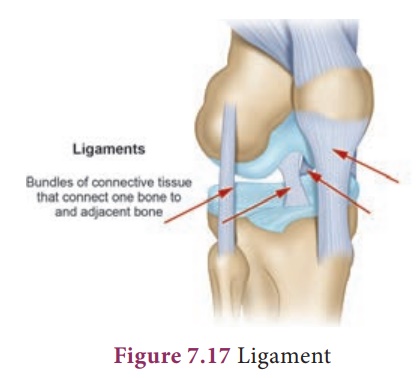Classification/Types, Functions | Animal Tissue - Connective Tissue | 9th Science : Organization of Tissues
Chapter: 9th Science : Organization of Tissues
Connective Tissue
Connective Tissue
It is one of the most
abundant and widely distributed tissue. It provides structural frame
work and gives support to different tissues forming organs.
The components of the connective tissue are the intercellular substance known
as the matrix, connective tissue cells and fibres. The matrix forms the main
bulk of the connective tissue. The main function of the connective tissue is
binding, supporting and packing together different organs of the body. It
prevents the organs from getting displaced by body movements.
Connective tissue is
classified as follows
i. Connective tissue proper (Areolar and Adipose tissue)
ii. Supportive connective tissue (Cartilage and Bone)
iii. Dense Connective tissue (Tendons and Ligaments)
iv. Fluid connective tissue (Blood and Lymph)

i. Connective tissue proper
Connective tissue proper
consist of collagen bres, elastin bres and broblast cells.
a. Areolar tissue
It has cells and fibres
loosely arranged in a semi fluid ground substance, matrix takes the form of
fine threads crossing each other in every direction leaving small spaces called
areolae. The matrix consists of collagen fibres, elastin fibres and fibroblast
cells. It joins skin to muscles, fills space inside organs and is found around
muscles, blood vessels and nerves. The matrix of this tissue plays an important
role in diffusion of oxygen and nutrients from small blood vessels. It also
helps in repair of tissues after injury and fixes skin to underlying muscles.

b. Adipose Tissue
Adipose tissue is the
aggregation of fat cells or adipocytes and serves as fat
reservoir. Each fat cell is a spherical or oval adipose cell and
contains a large droplet of fat.

The fat cells are
arranged into lobules separated by partitions of collagen and elastin fibres.
They are found in subcutaneous tissue, between internal organs around the heart
and kidneys. They keep the visceral organs in position and act as shock
absorbers around the kidneys and eye balls. They also regulate the body
temperature by acting as insulator.
ii. Supportive Connective Tissue
The supporting or
skeletal connective tissues forms the endoskeleton of the vertebrate body. They
support the body, protect various organs and help in locomotion. The supportive
tissues include Cartilage and Bone.
a. Cartilage
They are soft, semi-
rigid, flexible and are less vascular in nature. The matrix is composed of
large cartilage cells called chondrocytes. These cells are present in
fluid filled spaces known as lacunae.

Cartilage is present in
the tip of the nose, external ear, end of long bones, trachea and larynx. It
smoothens the surface at joints. It provides support and flexibility to the
body parts.
b. Bone
It is solid, rigid and
strong, non-flexible skeletal connective tissue. The matrix of the bone
is rich in calcium salts and collagen fibres which gives the bone its strength.
The matrix of the bone is in the form of concentric rings called lamellae.
The fluid filled spaces present between the lamellae are called lacunae in
which are present the bone cells called osteocytes that communicate with
each other by a network of fine canals called canaliculi. The hollow
cavities of spaces are called marrow cavities filled with bone marrow.
They provide shape and structural framework to the body. Bones support
and protect soft tissues and organs.

iii. Dense Connective Tissue
It is a fibrous
connective tissue densely packed with fibres and fibroblasts. It is the
principal component of tendons and ligaments.
a. Tendons
They are cord like,
strong, structures that join skeletal muscles to bones. Tendons have great strength
and limited flexibility. They consist of parallel bundles of collagen
fibres, between which are present rows of fibroblasts.

b. Ligaments
They are highly
elastic structures and have great strength which connect bones to bones.
They contain very little matrix. They strengthen the joints and allow normal
movement.

iv. Fluid connective tissue
The blood and the lymph
are the fluid connective tissues which link different parts of the body. The
cells of the connective tissue are loosely spaced and are embedded in an
intercellular matrix.
a. Blood
Blood contains
corpuscles which are red blood cells (erythrocytes), white blood cells (leucocytes)
and platelets. In this fluid connective tissue, the blood cells move in
a fluid matrix called plasma. The plasma contains inorganic salts and
organic substances. It is a main circulating fluid that helps in the transport
of substances.
Red blood corpuscles (Erythrocytes)
The red blood corpuscles
are oval shaped, circular, biconcave disc-like and lack nucleus when
mature (mammalian RBC). They contain a respiratory pigment called haemoglobin
which is involved in the transport of oxygen to tissues.
White blood corpuscles (Leucocytes)
They are larger in size,
contain distinct nucleus and are colourless. They are
capable of amoeboid movement and play an important role in body’s
defense mechanism. WBC’s are of two types
i. Granulocytes (with granules in the cytoplasm)
ii. Agranulocytes (without granules in the cytoplasm).
Granulocytes have irregular shaped
nuclei and cytoplasmic granules. They include the neutrophils, basophils
and eosinophils. Agranulocytes lack cytoplasmic granules
and include the lymphocytes which have a spherical nucleus and the monocytes
which have a large nucleus indented on one side. They engulf or destroy foreign
bodies and neutralise their harmful effects.
Blood platelets
They are minute,
anucleated, fragile fragments of giant bone marrow called mega karyocytes.
They play an important role in blood clotting mechanism.

b. Lymph
Lymph is a colourless
fluid filtered out of the blood capillaries. It consists of plasma and white
blood cells. It mainly helps in the exchange of materials between blood and
tissue fluids.
Related Topics